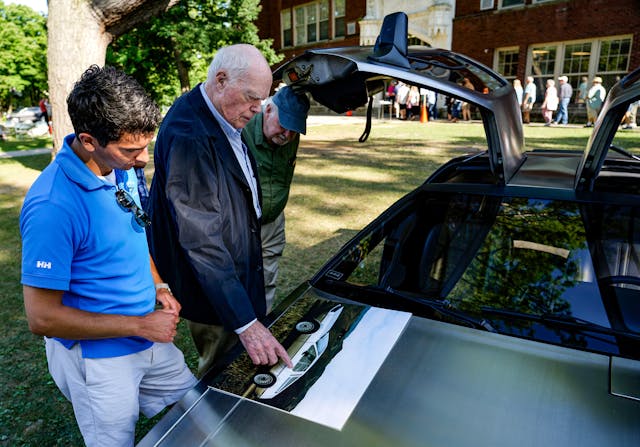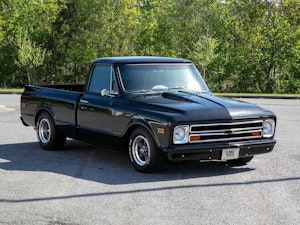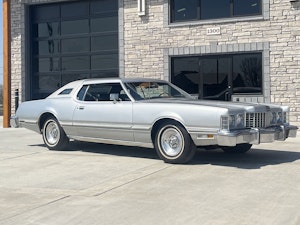Media | Articles
Dissed by DeLorean: Bill Collins, designer of the DMC-12 prototype, reflects

Bill Collins was an enthusiastic, creative, no-nonsense car guy who will be forever connected to John DeLorean, both through his career at Pontiac and in designing DeLorean’s ill-fated—and iconic—DMC-12. But Collins, who died on March 5, 2023, at the age of 91, was a community hero in Northport, Michigan, regardless of his automotive accomplishments. As the Leelanau Enterprise wrote, “The legacy of service to the community that Collins leaves behind is immeasurable, and can be seen in both the people and the projects still thriving today.”
In the story below, originally published in 2019, Collins discusses his relationship with DeLorean, his ultimate ouster from the company, and the release of the movie Framing John DeLorean. Here’s to one of the good guys. —JP
Bill Collins was part of something big. Something historic, as it turned out. And then he wasn’t. Perhaps it was for the best.
In the 1970s, Collins designed and built the prototype for the DeLorean DMC-12—a car that became both an automotive and Hollywood icon (thanks to Back to the Future)—and his work helped John Z. DeLorean secure a deal with Lotus founder Colin Chapman to engineer the car.
However, when DeLorean and Chapman procured a $17.65 million investment from a Swiss company called General Product Development (GPD), Collins was asked to sign a contract that essentially ousted him and gave Lotus full control of design and production.
Marketplace
Buy and sell classics with confidence
“I was upset with John. He forced me to resign,” says Collins, who was at the Traverse City (Michigan) Film Festival’s screening of Framing John DeLorean, a new docudrama in which he played a key role. “I think he was happy to see me go—he didn’t try to stop me. A short time later, in the early ’80s, when I tried to exercise my stock options, he and his lawyer wanted me to pay a withholding tax. There was no reason to do that. I just wanted what I had been promised.
“That was the last time I spoke to him.” DeLorean died on March 19, 2005.
20190802140514)
After Collins, now in his late 80s, left the DeLorean Motor Company in 1979 and started the Vixen Motor Company in 1981, the $17.65 million that DeLorean received from GPD went missing. A forensic accountant later determined that DeLorean and Chapman had laundered the money and split it. Desperate to save his floundering company, DeLorean was arrested by DEA agents in 1982 and charged with drug trafficking after taking part in a sting operation to sell cocaine. Although DeLorean was found not guilty, it was too late for his company and its stylish DMC-12 sports car.
Framing John DeLorean was a 15-year passion project for producer Tamir Ardon, who has always been fascinated with DeLorean’s stainless steel, gull-winged DMC-12. (He learned that a sedan was already in the works when the company folded, by the way.) Ardon’s unique film, which mixes interviews with reenactments starring Alec Baldwin as DeLorean, is the first DeLorean-based movie to be produced, although many other filmmakers have tried. Driven, a second, more-conventional DeLorean feature film, will be released later this month.
“I think Tamir had way too much about me in it,” Collins says of Framing John DeLorean, although he admits he played a big role in moving the car from concept to prototype. “I think [the movie] is very well done. It puts it all out there and lets you decide. And the make-up people did such a good job—[Baldwin] really does look like John DeLorean.”
What about Josh Charles, who portrays Collins? “The first time we saw the movie, my wife, Nina, said, ‘That’s supposed to be you, Bill. What’s he doing up there?’” Collins laughs. “I think he did a good job.”
Collins says he worked for John DeLorean longer than anyone—beginning as a GM engineer in December 1958 until he left DMC in March 1979. The two had a lot of shared success, including the hugely popular 1964 Pontiac GTO performance package that evolved into its own model, and, of course, the DMC-12 prototype, which was a vital tool to secure investors.
20190802140527)
“I wasn’t involved in the production [of the DMC-12], but the car was very close to the prototype,” Collins says. “The important thing was getting it to (Italian designer Giorgetto) Giugiaro. He was the right person. I think he did a good job of integrating a Lotus chassis with the shape.
“There are some little things I would have changed—like there’s nothing inside the car that tells you it’s a DeLorean. But the biggest thing is it should have had a bigger engine [than its 2.85-liter, fuel-injected aluminum PRV (Peugeot-Renault-Volvo) SOHC V-6, rated at 130 hp]. Everyone said it was underpowered, and they were right.
“DeLorean and Chapman should have gone out and gotten a better engine instead of stroking each other’s ego,” Collins says. “They were two peas in a pod.”
That’s about as critical as Collins is willing to get when it comes to DeLorean. When asked if he is bitter about how things went down, he chooses his words carefully.
“Well, I couldn’t bring myself to buy [a DeLorean] until 10 years ago. It took me that long,” he says. “And I changed the hood [from his ’82] because I like how the grooves look on the ’81.”

Collins assesses his two-decade-long friendship with DeLorean. “He was essentially my mentor at Pontiac. I was the guy who took his ideas and made them work—and I left Pontiac to join him. He was persuasive. But he was a different person [after GM]. The guy was not intellectually honest. We didn’t see that early on.”
On the bright side, Collins admits, “I learned something from it. I learned how to build something from nothing, starting with a clean sheet of paper. And I learned what to do and what not to do to raise money when I launched my own company.”
Near the end of Framing John DeLorean, DeLorean is asked in a television interview if he feels any regret about his failed DMC venture. He answers with a quote that he says is from Shakespeare, although the words were actually spoken by Alfred Lord Tennyson: “Tis better to have loved and lost than never to have loved at all.”
Do those words also apply to Collins’ DeLorean experience? He smiles. “I love that statement,” he says without elaborating further. “I think we all do.”
***
Check out the Hagerty Media homepage so you don’t miss a single story, or better yet, bookmark it. To get our best stories delivered right to your inbox, subscribe to our newsletters.










So: DeLorean and Chapman split the investment money, pocketed or squandered it, then were desperate for cash. I have to think there was more at play.
Plenty of people squander money. Why does there have to be more at play?
R.I.P. Mr. Collins. If nothing else, you spawned automotive history – well beyond “just” the car you drew up. The stories will be told and retold for as long as there are car people to tell them.
John was a big dreamer and a great engineer.
He pushed limits at GM and paid for in the end.
His long held dream was to build a 2 seat sports car. John had a big ego when he was building the Delorean and was willing to sell soul to the devil to save the car. I don’t think he started out to become what he became but the drive to build the car pushed him to so what he normally would not do.
It cost him this company, Rep, family, marriage and more.
John before he died was a shadow of what he once was. But he did admit he became a real jerk and hurt a lot of people. He did become a Christian and was a very humbled man.
I believe his blind drive to build the car made him easy picking for others.
From what I have read Colin was ruthless and would exploit anyone and anything in this era. Many have said this and a number of his dealings may have landed him in jail if his heart attack had not taken him.
As for Collins his legacy at Pontiac was extensive. I wish he had stayed at GM.
I had family member that was an head engineer at GM when John was there. He was one of the best product guys they had and engineer. But he pressed a lot of buttons with his flashy style. My relative was from the Sloan era and was not a John fan.
I did not know Bill personally but I purchased a sailboat from him, it is named “Yo!”. I have met so many people at different ports that have recognized and remembered Bill and the unique/rad name of the boat and talked with me about there times with him. We will not be changing the name of “Yo!”. In an odd coincidence, the year I purchased the boat from Bill, I sold a V70R to the General Manager of a vintage DeLorean shop! May the wind eternally fill your sails Mr. Collins.
RIP Bill, thanks for all your hard work on the DeLorean.
BTW, it was John’s ego that created the shift from the preproduction name of the car from “DMC-12” to what the car was eventually called, which is simply “DeLorean.” John wanted his name on the back of the car (see: Ferrari, Lamborghini, Porsche, etc), and not some cryptic combination of letters and numbers. This is why “DMC-12” does not appear anywhere on the car, the owners manual, or the certificate of origin.